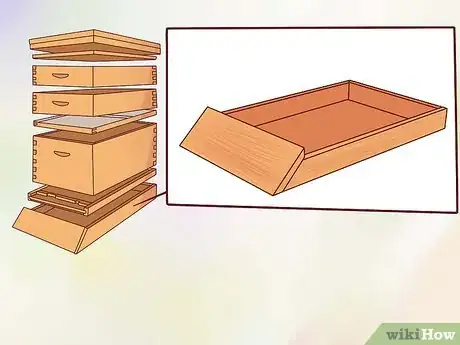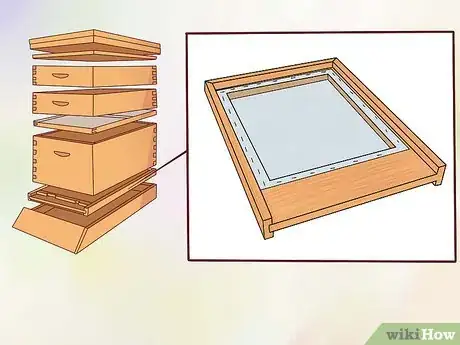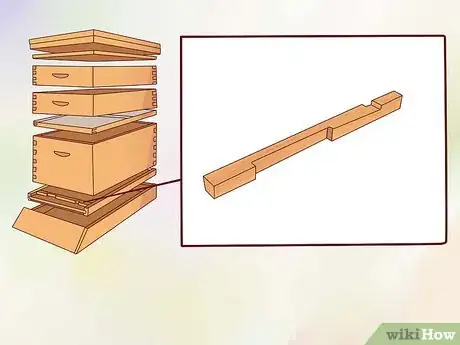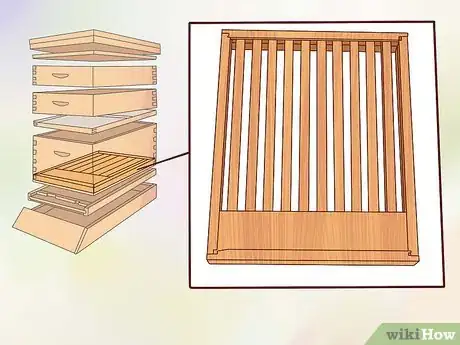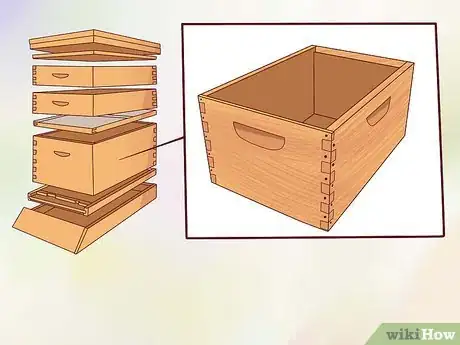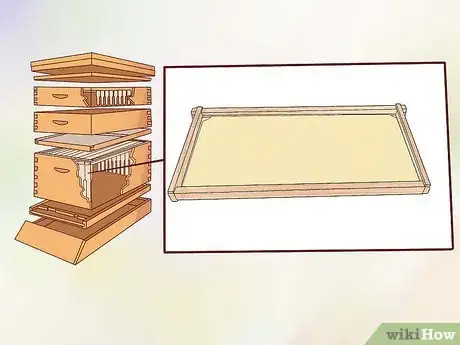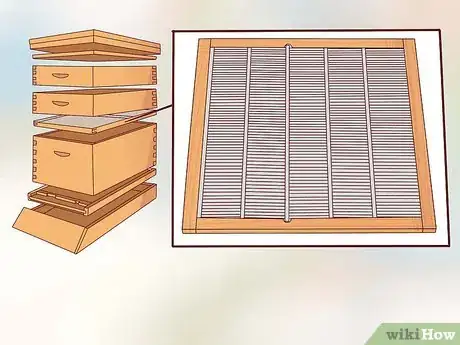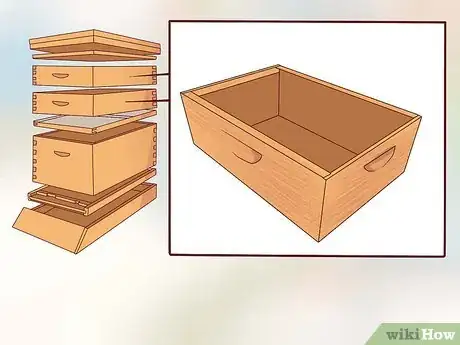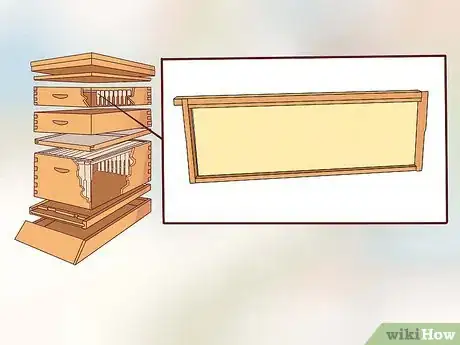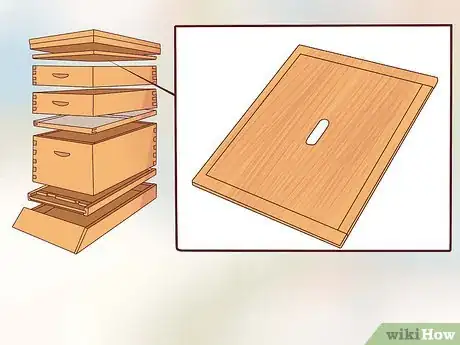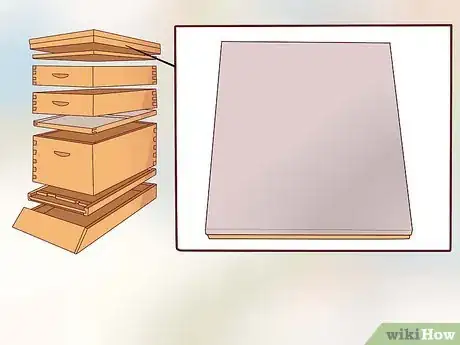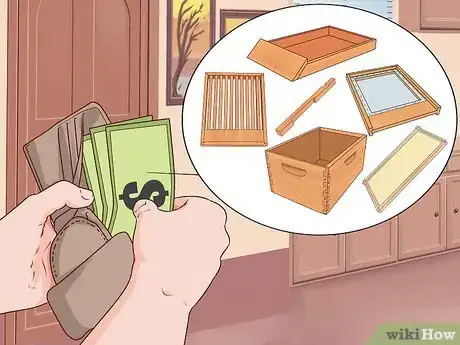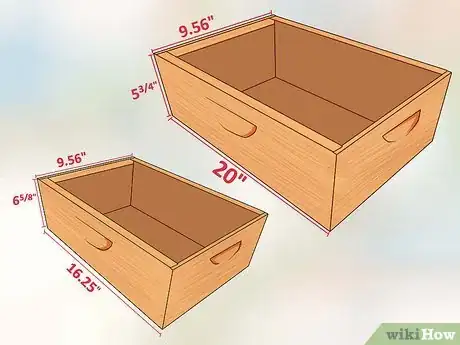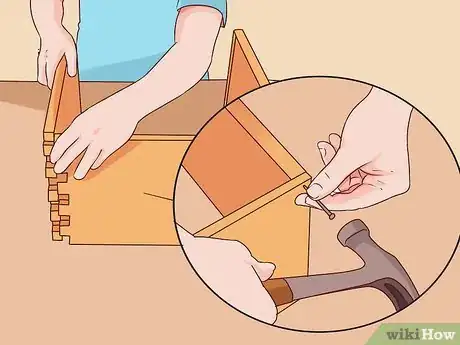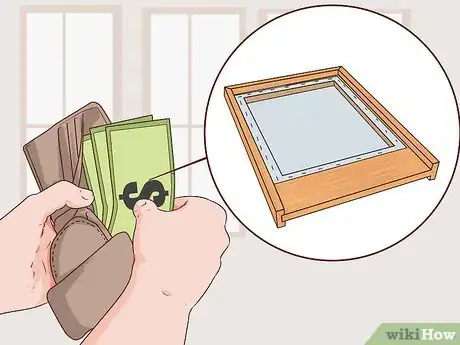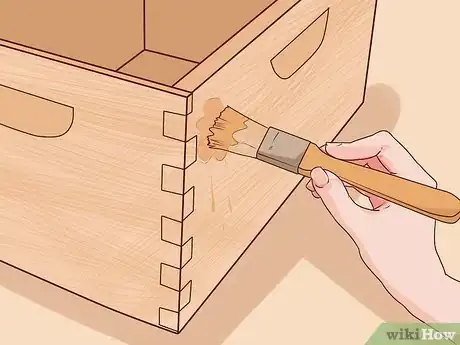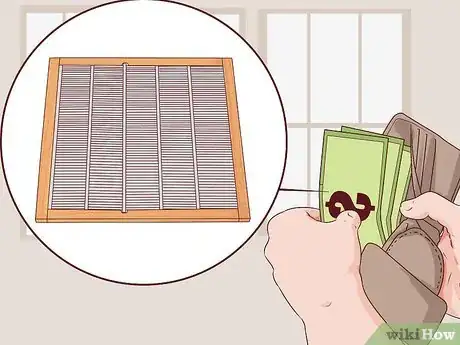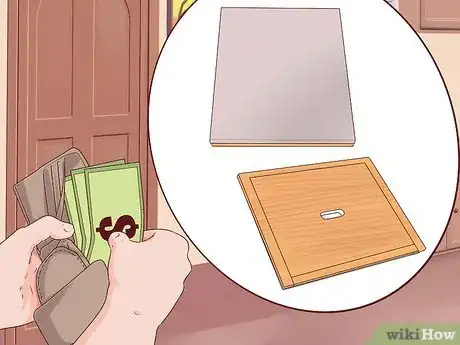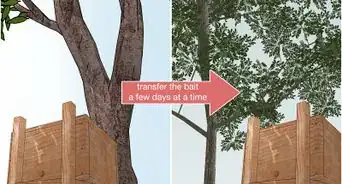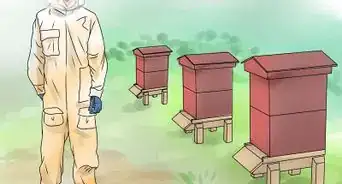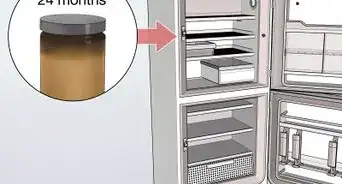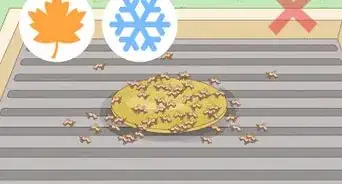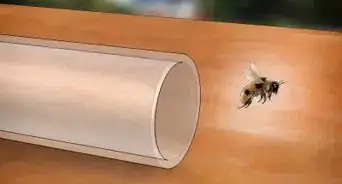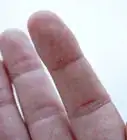This article was co-authored by David Williams. David Williams is a Professional Beekeeper and Bee Removal Specialist with over 28 years of beekeeping experience. He is the Owner of Bzz Bee Removal, a bee removal company based in the San Francisco Bay Area. Bzz Bee Removal locates, captures, and transports bees to local beekeepers to prevent colony collapse disorder.
There are 7 references cited in this article, which can be found at the bottom of the page.
wikiHow marks an article as reader-approved once it receives enough positive feedback. This article received 22 testimonials and 98% of readers who voted found it helpful, earning it our reader-approved status.
This article has been viewed 598,365 times.
People who have gardens and appreciate the importance of bees in the natural environment may seek to keep bees of their own. Bee boxes, or hives, today are designed to encourage the health of the bee society as well as make it easy for the beekeeper to remove the honey from the hive with the least disruption possible. A honey bee box is made up of a hive stand, bottom board, hive bodies (brooder), smaller boxes called honey supers, and a cover. The lower hive body is separated from the supers above by an excluder. Learn how to make a honey bee box to begin the beekeeping process.
Steps
Understanding the Parts
-
1Hive Stand.[1] This is the stand that lifts the hive off the ground, and may have an angled landing board for the bees. While you don’t need a technical ‘hive stand’, you will need a stand of sorts to prop your super off the ground. A small table or bench built to fit your honey bee box will work, if you’re looking for a home-made substitution.
-
2Bottom board. This is the first section/layer of your box. It is a flat piece of wood that serves as the base for your super.[2] The bottom board can either be solid or screened, the only difference being that screened bottom boards are better at keeping out pests and have an added bit of ventilation. Your bees will come and go from an entrance in the bottom board.Advertisement
-
3Entrance reducer. This is a small piece of wood that blocks off part of the entrance in the bottom board.[3] Entrance reducers help small colonies by preventing the entrance of large pests and robbers.
-
4Slatted rack. This is, just as it sounds, a flat panel of wood that is crossed by other small strips of wood, forming a flat rack. This is layered between the bottom board and the brood chamber, to provide ventilation, make access of the brood chamber easier, and prevents the bees from forming ladder comb. A slatted rack is an optional addition to your box, but it is well worth adding if you’re able.[4]
-
5Deep super. The deep super is the large box that the bees build their hive into. A deep super is the largest section, and you will use 1-2 for a single honey bee box. Each deep super comes with either 8 or 10 frames.
-
6Deep superframes. These are the frames that are individually inserted into the deep super. The frames hold foundation, which is the wax and wire base that the bees use to start their own wax building. You will need 8-10 deep superframes, depending on the size of your deep super.
-
7Queen excluder. Because you don’t want the queen bee to lay eggs in the honey, you add a queen excluder to your box. This is a flat rack that has small holes for the worker bees to use, but which are too small for the queen to use.
-
8Honey super. The honey super, like the deep super, is where the bees will store their honey. This is a large box placed on top of the deep super, with the queen excluder sandwiched between the two. It is normally easiest to work with shallow or medium-sized honey supers, otherwise it can become too heavy to lift the box full of honey.
-
9Honey superframes. Honey superframes are panels of wood or plastic that are inserted vertically into the honey super. These are where the bees build their wax and honey and can be removed from the super. Frames are either ‘shallow’ or ‘medium’ to match the size of the honey super you are using, and have a foundation similar to that in deep superframes.
-
10Inner cover. This is the final layer in your bee box - a type of lid with an entrance that is placed over your honey super. Inner covers have two sides - one for fall/winter, and one for spring/summer.[5]
-
11Outer cover. This is a metal lid that is used to keep adverse weather conditions from interfering with your bee box. This is the lid that tops off the box, over the top of the inner cover.[6]
Building Your Box
-
1Purchase your supplies. You have three choices when it comes to getting a honey bee box: buy a complete box for a lot of money, buy separate parts and put them together for less money, or build all your parts from scratch and save over 50% of your money. Regardless of which option you choose, you should always purchase your supplies from an esteemed bee seller. Buying cheap supplies not only will not last very long, it may also cause damage to your bees (and your honey!).
- Always use untreated wood - typically pine or cedar.[7]
- None of the boxes/supers have bottoms, so you’ll only need to purchase enough wood to create the outer edges for you multiple supers.
- Some supplies - like your frames and the outer lid - can’t be made easily, and you’ll have to buckle down and purchase them.
-
2Build your deep supers. There will be 2 short sides that are 16.25-by-9.56 inches (41.28-by-24.28 cm) and 2 long sides that are 20-by-9.56 inches (50.8-by-24.28 cm). All 4 sides will have tongue-and-groove or dovetailed ends. Cut your wood to meet these measurements, and create the proper joints along the edges.
-
3Build your honey supers. The size of your honey supers will vary depending on if you desire ‘shallow’ or ‘medium’ supers. The length/width of your honey supers will be the same as your deep supers (long side: 20-by-your height of 5.75 or 6.625 inches, short side: 16.25-by-height of 5.75 or 6.625 inches). The height will vary. For a shallow super, your box should be 5¾-inches high; a medium super will be 6⅝-inches high. Just like the deep super, use a tongue-and-groove or dovetailed joint on the edges.
-
4Assemble your supers. Use waterproof wood glue to put your supers together. Put a small dab of the glue on each of the interlocking joints, and slide the slats into place to form your boxes. Then, use a system of vices to hold the boxes in place while the glue dries. When the glue has completed drying, use a few small nails to finish off building your supers.[8]
-
5Buy or build the bottom board with an entrance reducer. The bottom board is the first layer of your box and is just a flat piece of wood with raised edges. The board will be the same length/width of the supers, but the height of the edges is only .375-inches high. Attached to the front is the entrance reducer; the entrance reducer needs to be .75 inches (1.91 cm) for the summer entrance and .38 inches (.95 cm) for the winter entrance.
- Entrances that are larger may encourage an infestation of rodents.
- Some commercially bought bases are reversible for the correct seasonal entrance. This reduces the cost of the setup as well as circumventing the need for the storage of 1 base during the off-season.
-
6Paint the exposed parts of your box. Although you don’t have to paint your box, many beekeepers prefer to paint the exposed parts of the box white in order to reflect sunlight. If you decide to do so, use a white, non-toxic outdoor paint which will withstand the weather. Never paint inside the supers though, as this can be harmful to the bees and your honey.
-
7Buy an excluder for your bee box. This fits on the top inside of the deep super and prevents the queen from moving into the honey supers. This is an item that can’t be made at home, and will have to be purchased for your box.
-
8Buy your covers for the box. There are two covers that are required for your honey bee box: the inner cover, and the outer cover. The inner cover is wood and has a hole at the top as an entrance, while the outer cover is metal and covers the top of the box. The outer cover should telescope out over the sides of the hive bodies and fit snugly.
-
9Get the frames for your supers. The frames are the portions of the box that the bees use to form their hive and wax. You can’t really make your own frames, unless you go through a long process of assembling the wire/foundation (which beginners shouldn’t do). Frames are made out of both wood and plastic, but both serve the same purpose. You’ll need 10 frames for each deep super, and 6-8 frames depending on the size of each of your honey supers. Slide these into each super vertically until they lock into place.
-
10Assemble your box. Now is the time you’ve been waiting for! To put your box together, you’ll need to layer all of the parts on top of your stand. The bottom board goes first, followed by the slatted frame (if you have one), then the deep super(s), queen excluder, honey super(s), and the cover.
- The hive stand can keep the beehive up off the ground to help keep the bottom dry and to insulate the hive. The hive stand can be made of anything that holds the hive up, or you can use a commercially purchased one.
- The hive stand will also protect your hive from ants.[9]
Expert Q&A
Did you know you can get expert answers for this article?
Unlock expert answers by supporting wikiHow
-
QuestionHow can I prevent ants from getting into the hive?
 David WilliamsDavid Williams is a Professional Beekeeper and Bee Removal Specialist with over 28 years of beekeeping experience. He is the Owner of Bzz Bee Removal, a bee removal company based in the San Francisco Bay Area. Bzz Bee Removal locates, captures, and transports bees to local beekeepers to prevent colony collapse disorder.
David WilliamsDavid Williams is a Professional Beekeeper and Bee Removal Specialist with over 28 years of beekeeping experience. He is the Owner of Bzz Bee Removal, a bee removal company based in the San Francisco Bay Area. Bzz Bee Removal locates, captures, and transports bees to local beekeepers to prevent colony collapse disorder.
Beekeeper & Bee Removal Specialist
-
QuestionWhat material do I use inside the frames?
 Community AnswerThis is optional. Some people put foundations to start them building, but foundationless is ideal if you want to cut it up for honeycomb.
Community AnswerThis is optional. Some people put foundations to start them building, but foundationless is ideal if you want to cut it up for honeycomb. -
QuestionWhat is the size of a bee frame?
 Community AnswerIt depends on how big you want the frame to be. Deep frames tend to be around 19 inches x 1+1/16 inches x 9+1/8 inches, medium-sized frames are 19 inches x 1+1/16 inches x 6+1/4 inches, and small, shallow frames are 19 inches x 1+1/16 inches x 5+3/8 inches.
Community AnswerIt depends on how big you want the frame to be. Deep frames tend to be around 19 inches x 1+1/16 inches x 9+1/8 inches, medium-sized frames are 19 inches x 1+1/16 inches x 6+1/4 inches, and small, shallow frames are 19 inches x 1+1/16 inches x 5+3/8 inches.
Things You'll Need
- Wooden ware for hive bodies
- All-weather wood glue
- Hammer
- Nails
- Newspapers or plastic
- White paint
- Paintbrush
- Baseboard
- Cover
- Hive stand
- Frames
References
- ↑ https://www.dummies.com/home-garden/hobby-farming/beekeeping/how-to-identify-the-basic-woodenware-parts-of-a-beehive/
- ↑ https://www.dummies.com/home-garden/hobby-farming/beekeeping/how-to-identify-the-basic-woodenware-parts-of-a-beehive/
- ↑ https://www.beverlybees.com/parts-beehive-beginner-beekeeper/
- ↑ https://www.beverlybees.com/parts-beehive-beginner-beekeeper/
- ↑ http://www.bushfarms.com/beestopentrance.htm
- ↑ http://www.beverlybees.com/parts-beehive-beginner-beekeeper/
- ↑ http://www.littlehouseonthebighill.com/beekeeping/index.php?detail=14
- ↑ http://www.beverlybees.com/assemble-bee-hive-box-super/
- ↑ David Williams. Professional Beekeeper. Expert Interview. 13 February 2020.
About This Article
To make a honey bee box, construct a large section called a deep super with 8-10 wax and wire frames that the bees will use to start making their own wax. Add a queen extruder, or a flat rack with holes that are large enough for the worker bees to get through but too small for the queen to keep her from laying eggs in the honey. Above the deep super and queen extruder, place the honey super, or a large box with honey frames. Make sure you have a secure cover for the boxes and place the structure on a stand with an entrance for the bees. Keep reading to learn the dimensions for your bee box!
